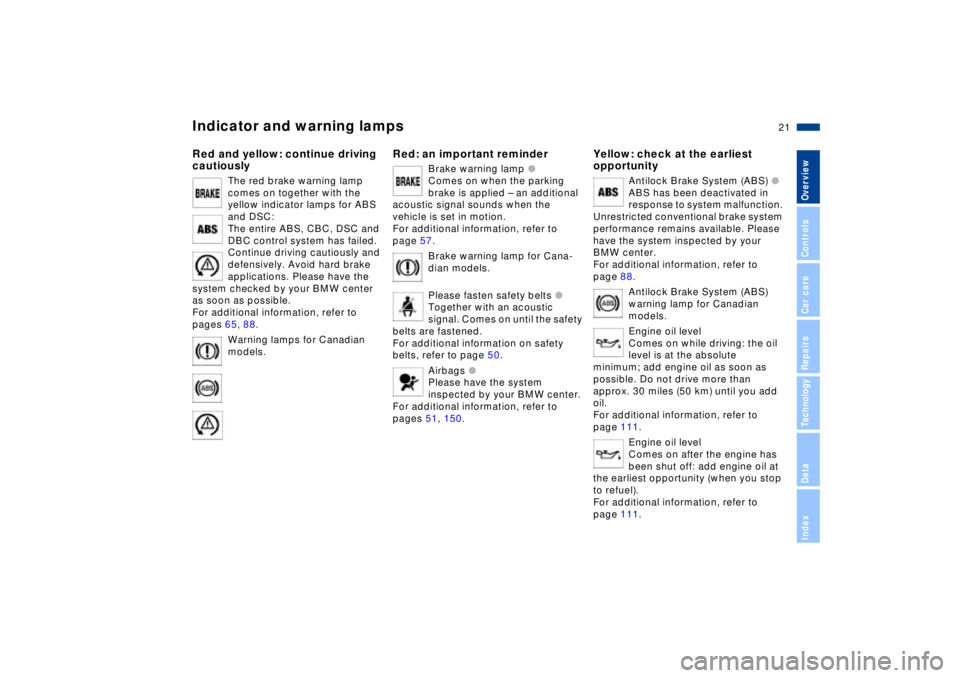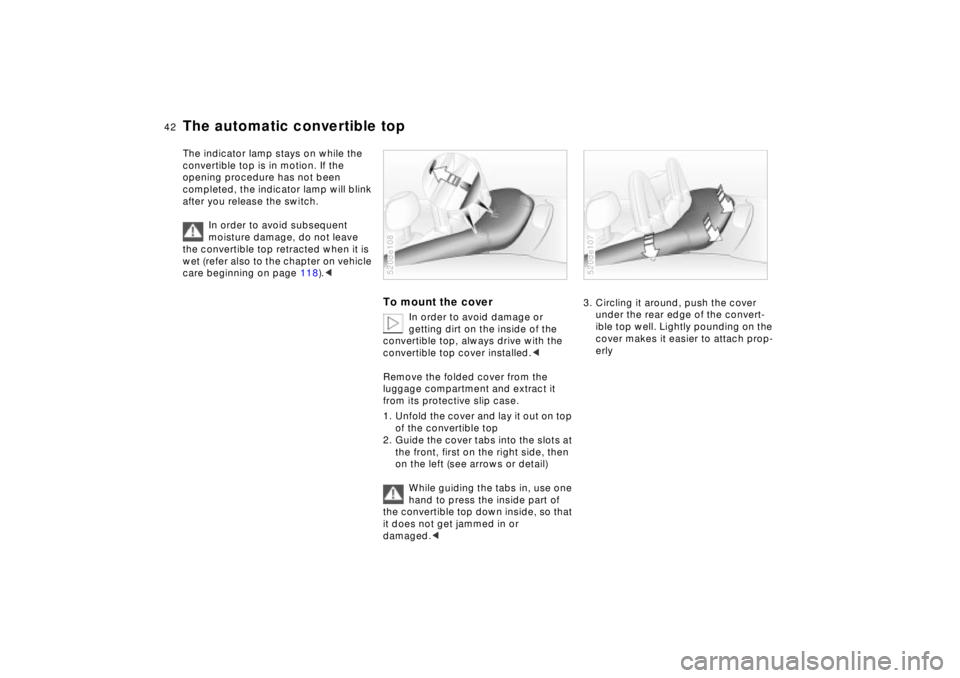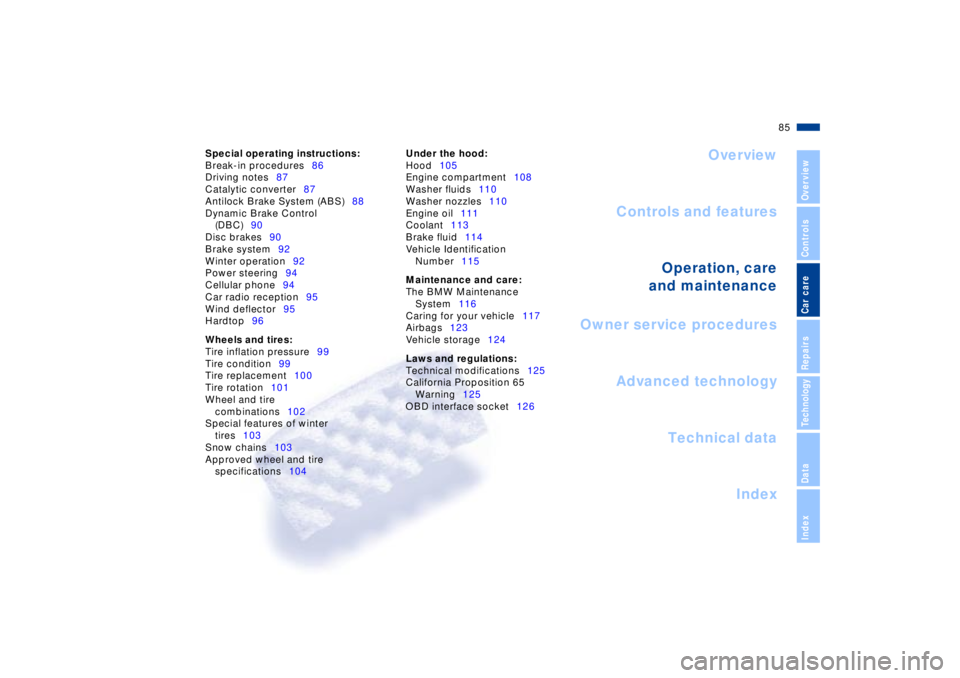ABS BMW Z8 CONVERTIBLE 2002 Owners Manual
[x] Cancel search | Manufacturer: BMW, Model Year: 2002, Model line: Z8 CONVERTIBLE, Model: BMW Z8 CONVERTIBLE 2002Pages: 174, PDF Size: 2.37 MB
Page 11 of 174

11n
Controls and features
Operation, care and maintenance
Lamps:
Parking lamps/Low beams69
Instrument lighting69
High beams/Standing lamps70
Rear fog lamp70
Interior lamps71
Reading lamps71
Controlling the climate for
pleasant driving:
Heating and ventilation/
Air conditioner72
Seat heating77
Interior conveniences:
Glove compartment78
Storage compartments78
Beverage holder80
Cellular phone81
Ashtray81
Cigarette lighter82
Loading and transporting:
Cargo loading83
Special operating instructions:
Break-in procedures86
Driving notes87
Catalytic converter87
Antilock Brake System (ABS)88
Dynamic Brake Control
(DBC)90
Disc brakes90
Brake system92
Winter operation92
Power steering94
Cellular phone94
Car radio reception95
Wind deflector95
Hardtop96
Wheels and tires:
Tire inflation pressure99
Tire condition99
Tire replacement100
Tire rotation101
Wheel and tire
combinations102
Special features of winter
tires103
Snow chains103
Approved wheel and tire
specifications104
Under the hood:
Hood105
Engine compartment108
Washer fluids110
Washer nozzles110
Engine oil111
Coolant113
Brake fluid114
Vehicle Identification
Number115
Maintenance and care:
The BMW Maintenance
System116
Caring for your vehicle117
Airbags123
Vehicle storage124
Laws and regulations:
Technical modifications125
California Proposition 65
Warning125
OBD interface socket126
Page 19 of 174

19n
IndexDataTechnologyRepairsCar careControlsOverview
Instrument cluster
1 Fuel gauge with indicator lamp for
fuel reserve62
2 Speedometer with indicator and
warning lamps for
>
Dynamic Stability Control
(DSC)22
>
Engine electronics22
3 Instrument panel lighting69
4 Tachometer62
with indicator and warning lamps
for:
>
Battery charge current20
>
Convertible top operation41
>
Flat Tire Monitor20
>
Antilock Brake System (ABS)21
>
Parking brake/Brake hydraulic
system/Cornering Brake Control
(CBC)20
>
Service Engine Soon22
>
Engine oil pressure/Engine oil
level20, 21
5 Coolant temperature gauge with
"Coolant temperature too high"
warning lamp63
6 Indicator and warning lamps for:
>
Rear fog lamp22
>
Turn signal, right23
7 Clock648 Control button for:
>
Clock64
>
Trip odometer, reset to zero62
9 Indicator and warning lamps for:
>
Please fasten safety belts21
>
High beams23
>
Airbags21
10 Indicator for:
>
Odometer62
>
Trip odometer62
>
Service Interval63
11 Indicator and warning lamps for:
>
Turn signal, left23
>
Brake pads22
Page 21 of 174

21n
IndexDataTechnologyRepairsCar careControlsOverview
Indicator and warning lamps
Red and yellow: continue driving
cautiously
The red brake warning lamp
comes on together with the
yellow indicator lamps for ABS
and DSC:
The entire ABS, CBC, DSC and
DBC control system has failed.
Continue driving cautiously and
defensively. Avoid hard brake
applications. Please have the
system checked by your BMW center
as soon as possible.
For additional information, refer to
pages 65, 88.
Warning lamps for Canadian
models.
Red: an important reminder
Brake warning lamp
l
Comes on when the parking
brake is applied Ð an additional
acoustic signal sounds when the
vehicle is set in motion.
For additional information, refer to
page 57.
Brake warning lamp for Cana-
dian models.
Please fasten safety belts
l
Together with an acoustic
signal. Comes on until the safety
belts are fastened.
For additional information on safety
belts, refer to page 50.
Airbags
l
Please have the system
inspected by your BMW center.
For additional information, refer to
pages 51, 150.
Yellow: check at the earliest
opportunity
Antilock Brake System (ABS)
l
ABS has been deactivated in
response to system malfunction.
Unrestricted conventional brake system
performance remains available. Please
have the system inspected by your
BMW center.
For additional information, refer to
page 88.
Antilock Brake System (ABS)
warning lamp for Canadian
models.
Engine oil level
Comes on while driving: the oil
level is at the absolute
minimum; add engine oil as soon as
possible. Do not drive more than
approx. 30 miles (50 km) until you add
oil.
For additional information, refer to
page 111.
Engine oil level
Comes on after the engine has
been shut off: add engine oil at
the earliest opportunity (when you stop
to refuel).
For additional information, refer to
page 111.
Page 42 of 174

42n
The automatic convertible topThe indicator lamp stays on while the
convertible top is in motion. If the
opening procedure has not been
completed, the indicator lamp will blink
after you release the switch.
In order to avoid subsequent
moisture damage, do not leave
the convertible top retracted when it is
wet (refer also to the chapter on vehicle
care beginning on page 118).<
To mount the cover
In order to avoid damage or
getting dirt on the inside of the
convertible top, always drive with the
convertible top cover installed.<
Remove the folded cover from the
luggage compartment and extract it
from its protective slip case.
1. Unfold the cover and lay it out on top
of the convertible top
2. Guide the cover tabs into the slots at
the front, first on the right side, then
on the left (see arrows or detail)
While guiding the tabs in, use one
hand to press the inside part of
the convertible top down inside, so that
it does not get jammed in or
damaged.<
520de108
3. Circling it around, push the cover
under the rear edge of the convert-
ible top well. Lightly pounding on the
cover makes it easier to attach prop-
erly520de107
Page 85 of 174

Overview
Controls and features
Operation, care
and maintenance
Owner service procedures
Technical data
Index Advanced technology
85n
IndexDataTechnologyRepairsCar careControlsOverview
Car care Special operating instructions:
Break-in procedures86
Driving notes87
Catalytic converter87
Antilock Brake System (ABS)88
Dynamic Brake Control
(DBC)90
Disc brakes90
Brake system92
Winter operation92
Power steering94
Cellular phone94
Car radio reception95
Wind deflector95
Hardtop96
Wheels and tires:
Tire inflation pressure99
Tire condition99
Tire replacement100
Tire rotation101
Wheel and tire
combinations102
Special features of winter
tires103
Snow chains103
Approved wheel and tire
specifications104Under the hood:
Hood105
Engine compartment108
Washer fluids110
Washer nozzles110
Engine oil111
Coolant113
Brake fluid114
Vehicle Identification
Number115
Maintenance and care:
The BMW Maintenance
System116
Caring for your vehicle117
Airbags123
Vehicle storage124
Laws and regulations:
Technical modifications125
California Proposition 65
Warning125
OBD interface socket126
Page 88 of 174

88n
Antilock Brake System (ABS)The concept ABS enhances active safety by helping
to prevent the wheels from locking
under braking. Why is this important?
When front wheels lock up and cease
to turn, the tires break into a slide.
Result: the driver loses the ability to
steer the vehicle. Traction loss at the
rear wheels can cause the back end of
the vehicle to slip sideways and break
away in uncontrolled oversteer.
With ABS, you will achieve the shortest-
possible braking distances under all
given conditions (braking while driving
straight ahead or in curves, different
road surfaces).
ABS is designed to meet two essential
requirements during every brake appli-
cation:
>To help provide vehicle stability
>To help retain steering and maneu-
vering capability on all types of road
surfaces (asphalt, concrete, dirt, wet
surfaces, snow and ice).
Braking with ABSThe system is operative once the
vehicle exceeds a speed of approx.
6 mph (10 km/h). The ABS is deacti-
vated whenver the vehicle's speed
drops back below approx. 4 mph
(6 km/h). This means that the wheels
can lock only in the final phase of a
panic stop Ð a factor of no substantive
significance in actual use.
The ABS system works best in situa-
tions requiring maximum pressure on
the pedal (full braking). Since the
vehicle maintains steering responsive-
ness, you can nevertheless avoid
possible obstacles with a minimum of
steering effort.
The ABS system's closed-loop control
circuit cycles in fractions of a second.
A pulsing of the brake pedal, combined
with the sounds associated with the
hydraulic controls, tells you that the
brake system is within its maximum
limit range and reminds you that you
should adapt your vehicle's speed to
road conditions. On road surfaces that have a loose
surface layer on a firm base with good
traction (on gravel, deep sand or snow,
for example), braking distances may be
longer than with locked wheels. This
also applies to driving with snow
chains. However, ABS continues to
provide enhanced vehicle stability and
steering response under these condi-
tions.
Page 89 of 174

89n
IndexDataTechnologyRepairsCar careControlsOverview
Antilock Brake System (ABS)Information for your safetyNot even ABS can suspend the laws of
physics. The consequences of brake
applications with inadequate clear-
ances for safety between vehicles,
excessive speed or if aquaplaning
occurs are always the responsibility of
the driver. You should never allow the
added safety provided by ABS to
mislead you into taking risks of any
kind.
Do not make any modifications to
the ABS system.
Service procedures on ABS are to be
performed by authorized technicians
only.<
In case of a system malfunction
If the ABS warning lamp comes
on, refer to page 21. The brake
system will then function the
same as on vehicles without
ABS. However, have the brake
system checked by your BMW
center as soon as possible. To prevent
undetected defects and cumulative
faults from adversely affecting the
brake system, refer any problems to
your BMW center at the earliest oppor-
tunity.
Cornering Brake Control (CBC)CBC is an advanced ABS engineering
design. Vehicle stability is also
enhanced when braking during
cornering at high rates of lateral accel-
eration and during lane changes.
Page 90 of 174

90n
Dynamic Brake Control (DBC) Disc brakesIf you step on the brake rapidly, this
system automatically produces maxi-
mum braking force boost and thus
helps to achieve the shortest-possible
braking distance during "panic stops."
All of the benfits of the ABS system are
exploited under these circumstances.
Do not reduce the pressure on the
brake pedal during the brake applica-
tion. When the brake pedal is released,
the DBC is deactivated.
In the event of a malfunction,
the yellow brake warning lamp
comes on. Normal braking effi-
ciency and ABS are still fully
available. Have the system
checked and repaired at your
BMW center as soon as possible.
For your safetyNot even DBC can suspend the laws of
physics. The consequences of brake
applications with inadequate clear-
ances for safety between vehicles,
excessive speed or if aquaplaning
occurs are always the responsibility of
the driver. You should never allow the
added safety provided by DBC to
mislead you into taking risks of any
kind.Disc brakes furnish optimal decelera-
tion and braking control and greater
fade resistance under heavy use.
When the vehicle is driven only occa-
sionally, during extended periods when
the vehicle is not used at all, or in oper-
ating conditions where brake applica-
tions are less frequent, there is an
increased tendency for corrosion of the
rotors and accumulation of contamina-
tion on the brake pads. This occurs
because the minimal pressure which
must be exerted by the pads to clean
the disc brakes by brake applications is
not achieved.
If the brake rotors are corroded, they
will tend to respond to braking with a
pulsating effect that even extended
brake applications will fail to cure.
For your own safety: use only
brake pads BMW has approved
for your specific vehicle model. BMW
cannot evaluate non-approved brake
pads to determine if they are suited for
use, and therefore cannot ensure the
operating safety of the vehicle if they
are installed.<
Page 91 of 174

91n
IndexDataTechnologyRepairsCar careControlsOverview
Disc brakesDriving notesWhen driving in heavy rain and on wet
roads it is advisable to apply light pres-
sure to the brake pedal every few miles.
Monitor traffic conditions to ensure that
this maneuver does not pose a hazard
to you or to other road users. The heat
generated in this braking process helps
dry the pads and rotors
Maximum braking force is obtained
while the wheels are not locked, but
rather when they are still barely turning
immediately prior to locking. ABS main-
tains this state automatically. If the ABS
fails, you should revert to the staggered
braking technique (refer to page 93).
When descending steep hills and
extended grades, downshift to a gear
that will allow you to continue safely
with only a minimal amount of braking.
By minimizing the loads placed on the
brake system, this strategy helps
ensure that optimal brake system
response will remain available at all
times.
You can enhance the engine's braking
effect by downshifting, into first gear, if
necessary. Even if engine braking fails to slow the
vehicle sufficiently, you should still
make every effort to avoid prolonged
braking with continuous application of
low to moderate pressure at the pedal.
It is better to decelerate the vehicle by
applying a higher level of force at the
pedal (watch following traffic!) and then
subsequently pausing to allow the
brakes to cool briefly before starting on
your next braking cycle. By protecting
brake system components against
overheating, the cooling phases
afforded by this staggered, or intermit-
tent braking technique help maintain
consistent availability of optimal braking
response when it is needed.
Do not coast with the clutch pedal
depressed, the gear-shift lever in
neutral, or, above all, with the engine
off; otherwise, the engine will provide
no braking effect if the transmission is
in neutral, and there is no braking or
steering power assist if the engine is
not running. Never allow floor mats,
carpets or any other objects to obstruct
the accelerator, clutch or brake pedals
and pose a safety hazard by reducing
their available travel range.<
Page 93 of 174

93n
IndexDataTechnologyRepairsCar careControlsOverview
Winter operationRubber seals and componentsTo prevent the weather-stripping from
freezing, apply a spray-on rubber treat-
ment or silicone spray to the door, hood
and luggage compartment lid seals.
A full range of car-care products is
available from your BMW center.
on rear tires, complying with the manu-
facturer's safety precautions. Do not
exceed a maximum speed of 30 mph
(50 km/h) while the snow chains are
mounted and refrain from activating the
Flat Tire Monitor, as the snow chains
could trigger false alarms and/or
prevent the system from detecting
actual pressure loss.
Starting off When starting off in deep snow or when
"rocking" the vehicle to free it, it may be
advisable to temporarily deactivate the
DSC. Refer to page 65.
To maintain vehicle stability,
always drive with the system
switched on whenever possible.<
Driving on low-traction road
surfaces Do not activate the Sport mode (refer to
page 66). Use smooth, gentle pressure
to control the accelerator pedal. Avoid
excessive engine speeds and upshift
early. Downshift well in advance when
approaching uphill or downhill grades.
Maintain an adequate distance
between yourself and the vehicle
ahead. BrakesWinter road conditions substantially
reduce the amount of traction available
between the tires and the road surface.
The resulting increases in braking
distance are considerable and should
be kept in mind at all times.
ABS is intended to prevent the wheels
from locking during brake applications,
thus helping to maintain vehicle stability
and steering response. If the ABS does not respond in a critical
braking situation and the wheels lock,
reduce the pressure on the brake pedal
until the wheels just start to roll again
while still maintaining enough force to
continue braking.
Then increase the pressure, reduce the
pressure when the wheels lock, reapply
pressure etc.
This staggered braking procedure will
reduce braking distances while helping
you maintain steering control.
You can always then attempt to steer
around hazards after you have reduced
pressure on the brake pedal.
Never downshift to exploit engine
braking when driving on slippery
road surfaces, as this could lead to a
loss of traction at the rear wheels,
impairing your ability to control the
vehicle.<
Depress the clutch during hard
braking on road surfaces that
provide only poor or uneven traction.<